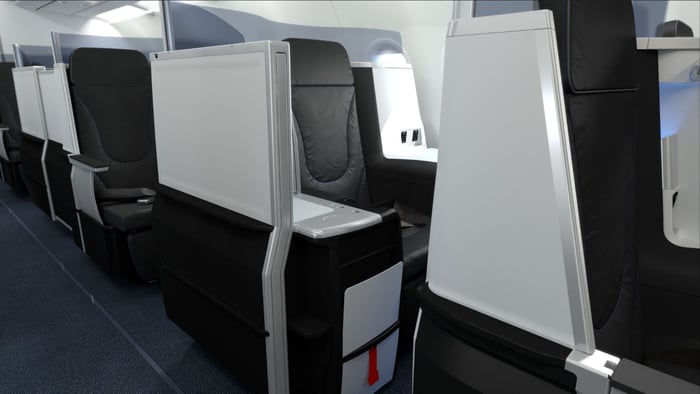On Tuesday morning, JetBlue Airways (JBLU -1.40%) reported very strong second-quarter earnings results. Unit revenue returned to growth in a big way, thanks to improving demand and favorable timing of holidays, driving a 12% year-over-year increase in revenue. Meanwhile, earnings per share surged 21% to $0.64, well ahead of the average analyst estimate of $0.57.
However, while these metrics are all impressive, the best piece of news from JetBlue's earnings report related to strong demand for its new Mint premium service routes. This bodes well for 2018 unit revenue at JetBlue, because the carrier is in the midst of rolling out Mint service in many new markets.
Mint continues to deliver phenomenal results
JetBlue introduced its Mint premium service three years ago, using a dedicated fleet of Airbus A321s. Coach passengers get perks like larger seatback screens, more channels of free satellite TV, and an unlimited snack bar. But the highlight is a 16-seat premium cabin featuring lie-flat seats, a variety of upscale amenities, and attentive service.

JetBlue's Mint premium cabin has received rave reviews. Image source: JetBlue Airways.
These Mint flights have attracted a devoted following, and it shows. In the two years after JetBlue launched Mint service on its New York-Los Angeles and New York-San Francisco routes, profit margins on those flights improved by a stunning 17-18 percentage points compared to the rest of JetBlue's route network.
After launching Mint on its initial two New York-California routes in 2014, JetBlue added more flights on those routes in 2015. It then began serving the Boston-San Francisco and Boston-Los Angeles markets with Mint-configured aircraft in 2016.
Meanwhile, JetBlue has repeatedly raised Mint fares, reacting to strong demand. On Tuesday, JetBlue executive Marty St. George noted that the carrier implemented its 14th Mint fare increase last quarter.
JetBlue's Fort Lauderdale Mint expansion is off to a great start
Earlier this year, JetBlue expanded Mint service to its Fort Lauderdale focus city. It upgraded the Fort Lauderdale-Los Angeles route to Mint service in March, followed by the Fort Lauderdale-San Francisco route in May. This is part of a broader plan to add eight new transcontinental Mint markets by 2018.

JetBlue will soon replace A320s with Mint-equipped A321s on six routes. Image source: JetBlue Airways.
The early results from these new Mint routes are extremely promising. JetBlue has recently generated year-over-year unit revenue increases of more than 20% for its Fort Lauderdale Mint markets.
While unit costs are slightly higher for a Mint-equipped A321 compared to a standard JetBlue A320, this big uptick in unit revenue implies double-digit margin gains. If JetBlue's Fort Lauderdale Mint service follows the same pattern as the carrier's earlier Mint routes, there will be further margin expansion in the next year or two.
JetBlue is just getting started
Whereas JetBlue added six Mint-configured planes to its fleet in 2016 and four Mint planes in the first half of 2017 (one of which did not even enter service until July), it plans to add nine Mint planes to its fleet between now and year-end. Additionally, a portion of JetBlue's 11 scheduled A321 deliveries next year will come in the Mint configuration.
This fleet growth will allow JetBlue to launch Mint service on six more routes between now and April, connecting New York and Boston to San Diego, Las Vegas, and Seattle. It also plans to add flights on several existing Mint routes during that period.
JetBlue has shown that the Mint product "travels" well between different markets. It has been a big hit in New York and Boston and the early results in Fort Lauderdale look great as well. As JetBlue ramps up Mint service, it should see a meaningful unit revenue boost. Given that the bulk of the Mint service increases will occur in late 2017 and early 2018, most of this benefit will come next year.
In other words, JetBlue is already posting solid financial results, but the carrier is well positioned to take another step forward in terms of profitability during 2018. If JetBlue can find further growth opportunities for Mint in future years -- which shouldn't be too hard -- there will be even more upside for the company and its shareholders.




